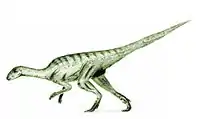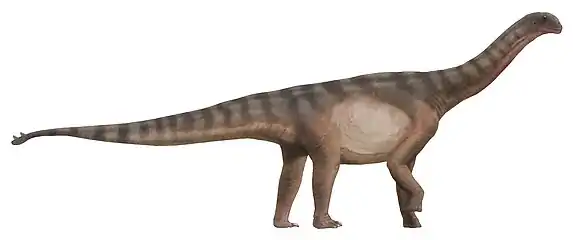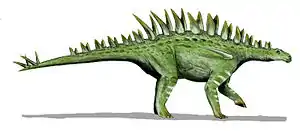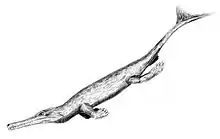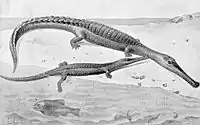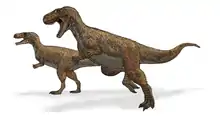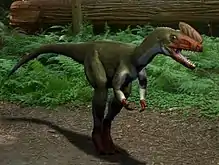Bathonian
In the geologic timescale the Bathonian is an age and stage of the Middle Jurassic. It lasted from approximately 168.3 Ma to around 166.1 Ma (million years ago). The Bathonian age succeeds the Bajocian age and precedes the Callovian age.[2]
| Bathonian | |
|---|---|
| 168.3 ± 1.3 – 166.1 ± 1.2 Ma | |
| Chronology | |
Key events in the Jurassic -200 — – -195 — – -190 — – -185 — – -180 — – -175 — – -170 — – -165 — – -160 — – -155 — – -150 — – -145 — – how to approximate the timescale of key Jurassic events. Vertical axis: millions of years ago. | |
| Etymology | |
| Name formality | Formal |
| Usage information | |
| Celestial body | Earth |
| Regional usage | Global (ICS) |
| Time scale(s) used | ICS Time Scale |
| Definition | |
| Chronological unit | Age |
| Stratigraphic unit | Stage |
| Time span formality | Formal |
| Lower boundary definition | FAD of the Ammonite Gonolkites convergen |
| Lower boundary GSSP | Ravin du Bès, Bas-Auran, Alpes de Haute, France 43.9606°N 6.3153°E |
| GSSP ratified | July 2008[1] |
| Upper boundary definition | Not formally defined |
| Upper boundary definition candidates | FAD of the Ammonite genus Kepplerites |
| Upper boundary GSSP candidate section(s) | |
Stratigraphic definitions
The Bathonian stage takes its name from Bath, a spa town in England built on Jurassic limestone (the Latinized form of the town name is Bathonium). The name was introduced in scientific literature by Belgian geologist d'Omalius d'Halloy in 1843. The original type locality was located near Bath. The French palaeontologist Alcide d'Orbigny was in 1852 the first to define the exact length of the stage.
The base of the Bathonian is at the first appearance of ammonite species Parkinsonia (Gonolkites) convergens in the stratigraphic column. The global reference profile for the base of the Bathonian (a GSSP) was ratified as Ravin du Bès, Bas-Auran area, Alpes de Haute Provence, France in 2009.[3] The top of the Bathonian (the base of the Callovian stage) is at the first appearance of ammonite genus Kepplerites.
In the Tethys domain, the Bathonian contains eight ammonite biozones:
- zone of Clydoniceras discus
- zone of Hecticoceras retrocostatum
- zone of Cadomites bremeri
- zone of Morrisiceras morrisi
- zone of Tulites subcontractus
- zone of Procerites progracilis
- zone of Procerites aurigerus
- zone of Zigzagiceras zigzag
Rocks of Bathonian age are well developed in Europe: in the northwest and southwest oolite limestones are characteristically associated with coral-bearing, crinoidal and other varieties, and with certain beds of clay. In the north and northeast, Russia, etc., clays, sandstones and ferruginous oolites prevail, some of the last being exploited for iron. They occur also in the extreme north of North America and in the Arctic regions, Greenland, Franz Josef Land, etc.; in Africa, Algeria, Tanzania, Madagascar and near the Cape of Good Hope (Enon Beds); in India, Rajputana and Gulf of Kutch, and in South America.[4]
The well-known Caen stone of Normandy and "Hauptrogenstein" of Swabia, as well as the "Eisenkalk" of northwest Germany, and "Klaus-Schichten" of the Austrian Alps, are of Bathonian age.[4]
Palaeontology
Amphibia
| Amphibians of the Bathonian | ||||
|---|---|---|---|---|
| Taxa | Presence | Location | Description | Images |
|
La Matilde Formation, Patagonia Argentina | An extinct genus of archaeobatrachian frog and a member of the extant family Ascaphidae. One of the oldest true frogs discovered. | ||
†Ankylosaurs
| Ankylosaurs of the Bathonian | ||||
|---|---|---|---|---|
| Taxa | Presence | Location | Description | Images |
|
A Chinese ankylosaur which lacked a club at the end of its tail. it could possibly be a nodosaur. | |||
†Ornithopods
| Ornithopods of the Bathonian | ||||
|---|---|---|---|---|
| Taxa | Presence | Location | Description | Images |
|
A 5-foot-long (1.5 m) bipedal herbivore that was built for speed. It was discovered in one of China's many Callovian deposits. | |||
|
Bathonian to Callovian | Lower Shaximiao Formation, Sichuan, China | A small ornithischian dinosaur distinguished from all other basal ornithischians by a single autapomorphy, the presence of a marked concavity that extends over the lateral surface of the postorbital. | |
|
A poorly known Chinese ornithschian that may be related to Hypsilophodon and Lesothosaurus. It was small and vegetarian. | |||
|
Dashanpu Formation, Sichuan, China | A 5-foot-long (1.5 m) Chinese herbivore in the family hypsilophodontidae. | ||
†Sauropods
| Sauropods of the Bathonian | ||||
|---|---|---|---|---|
| Taxa | Presence | Location | Description | Images |
| Abrosaurus was a small (30-foot (9.1 m) adult length) sauropod from China with an unusual skull. |
 Cetiosaurus with Megalosaurus | |||
| A sauropod named after the mountains where the mythological figure that held the world on his shoulders, it attained lengths of 15 meters (50 ft) and lived in Morocco. | ||||
| "Bothriospondylus" madagascariensis | ||||
| Taynton Limestone Formation, England | Cetiosaurus was a large mid to low browsing sauropod from England reaching lengths to 16 meters (50 feet) long, it was possibly the largest dinosaur of its time. it was also hunted by Megalosaurus. | |||
| Bathonian-Oxfordian | Tiourarén Formation, Niger | Jobaria was one of the largest sauropods of the Bathonian, reaching 18 meters (60 feet) long, this sauropod was discovered in what is now Niger. It was also thought to have lived from the Hauterivian to Barremian of the Early Cretaceous | ||
| Forest Marble Formation, Wiltshire, England | A dubious sauropod, possibly a macronarian | |||
| Lower Shaximiao Formation, Sichuan, China | A 10-meter-long, fairly short-necked sauropod with a short deep skull, with fairly robust spatulate teeth. Its tail ended in a club, probably used for fending off predators. | |||
| Shaximiao Formation, Sichuan, China | ||||
†Stegosauria
| Stegosaurs of the Bathonian | ||||
|---|---|---|---|---|
| Taxa | Presence | Location | Description | Images |
| Bathonian to Callovian | Lower Shaximiao Formation, Sichuan, China | A 4.5-meter herbivore with a small skull and a spiked tail. Bore the distinctive double row of plates, rising vertically along its arched back, of all the stegosaurians and two pairs of long spikes extending horizontally near the end of its tail | ||
†Plesiosaurians
| Plesiosaurians of the Bathonian | ||||
|---|---|---|---|---|
| Taxa | Presence | Location | Description | Images |
| Bajocian-Tithonian | Oxfordshire | A 6 meter long pliosaur that lived until the end of the Jurassic period |  Restoration of S. vorax - | |
†Thalattosuchians
| Thalattosuchians of the Bathonian | ||||
|---|---|---|---|---|
| Taxa | Presence | Location | Description | Images |
| Bathonian | Madagascar | A machimosaurid teleosauroid. | ||
| Bathonian | England | A machimosaurid teleosauroid. | ||
| Bathonian | Cornbrash Formation of England, and France | A machimosaurid teleosauroid. | ||
| Bajocian-Bathonian | France | A basal metriorhynchoid. | ||
| earliest Bathonian | Italy | A geosaurine metriorhynchid. | ||
| Bathonian | Cornbrash Formation and Forest Marble Formation of England, and Calcaire de Caen of France | A machimosaurid teleosauroid. | ||
| Bathonian | France | A basal metriorhynchoid. | ||
| Bathonian | France | A teleosaurid teleosauroid. | ||
| Bathonian | Cornbrash Formation of England, and France | A machimosaurid teleosauroid. | ||
Theropods
| Theropods of the Bathonian | ||||
|---|---|---|---|---|
| Taxa | Presence | Location | Description | Images |
| Bathonian-Oxfordian | Tiourarén Formation, Niger | Afrovenator was a megalosaurid and the largest carnivorous dinosaur of the Bathonian, reaching 8.5 meters (28 feet) long, this theropod was discovered in what is now Niger. It was also thought to have lived from the Hauterivian to Barremian of the Early Cretaceous | ||
| Lower Bathonian | Chipping Norton Limestone Formation, England | A basal tetanuran only known from a few remains. | ||
| Calcaire de Caen Formation, France | A megalosaurid theropod from France. | |||
| Bathonian- Callovian | Lower Shaximiao Formation, Sichuan, China | An 11–13 foot predator from China whose discovery was assisted by the petroleum industry. It may be the most basal coelurosaurian yet known, a carnosaur or may even be close to the common ancestor of the two groups. | ||
| Stonesfield Slate, Oxfordshire | A 6-foot-long (1.8 m) European tetanuran theropod of uncertain affinities. Possibly a small megalosaurid or the earliest known tyrannosauroid. | |||
| Itat Formation, Sharypovsky District, Krasnoyarsk Krai, Russia | One of the earliest tyrannosauroid dinosaurs. Similar but somewhat larger than its contemporary and closely related Proceratosaurus. | |||
| Lower/Middle Bathonian | Taynton Limestone Formation, England | The first dinosaur to receive a formal scientific description, Megalosaurus was a 27-foot (8.2 m) carnivore which prowled Jurassic England. | ||
| Calcaire de Caen Formation | A carnosaurian theropod from France. | |||
| Bathonian[6] | Forest Marble Formation | Proceratosaurus was the earliest definite tyrannosauroid to ever be discovered. It was around 3 meters long. | ||
| Bathonian-Oxfordian | Tiourarén Formation, Niger | A large ceratosaurian which coexsisted with Afrovenator. | ||
| Lower Shaximiao Formation | A 26-foot Chinese theropod. Yangchuanosaurus' specimens from this time period were formerly classed in a separate later genus, Szechuanosaurus. | |||
†Ammonitida
| †Ammonitids of the Bathonian | ||||
|---|---|---|---|---|
| Taxa | Presence | Location | Description | Images |
| Confirmed.[7] |  Life restorations of two different ammonite genera. | |||
| Confirmed.[7] | ||||
| Confirmed.[7] | ||||
| Confirmed.[7] | ||||
| Confirmed.[7] | ||||
| Confirmed.[7] | ||||
| Confirmed.[7] | ||||
| Confirmed.[7] | ||||
| Confirmed.[7] | ||||
| Confirmed.[7] | ||||
|
Confirmed.[7] | |||
†Belemnites
| Belemnites of the Bathonian | ||||
|---|---|---|---|---|
| Taxa | Presence | Location | Description | Images |
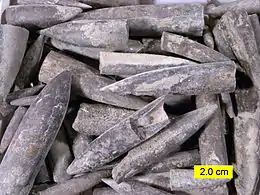 Belemnite fossils | ||||
References
Notes
- Fernández-López, Sixto Rafael; Pavia, Giulio; Erba, Elisabetta; Guiomar, Myette; Maria Helena Henriques; Lanza, Roberto; Mangold, Charles; Morton, Nicol; Olivero, Davide; Daniele Tiraboschi (2009). "The Global Boundary Stratotype Section and Point (GSSP) for base of the Bathonian Stage (Middle Jurassic), Ravin du Bès Section, SE France" (PDF). Episodes. 32 (4): 222–248. doi:10.18814/epiiugs/2009/v32i4/001.
- For a detailed geologic timescale, see Gradstein et al. (2004)
- López, Fernández; Rafael, Sixto; Pavia, Giulio; Erba, Elisabetta; Guiomar, Myette; Paiva Henriques, María Helena; Lanza, Roberto; Mangold, Charles; Morton, Nicol; Olivero, Davide; Tiraboschi, Daniele (2009). "The Global Boundary Stratotype Section and Point (GSSP) for base of the Bathonian Stage (Middle Jurassic), Ravin du Bès Section, SE France" (PDF). Episodes. 32 (4): 222–248. doi:10.18814/epiiugs/2009/v32i4/001. Archived from the original (PDF) on 4 March 2016. Retrieved 5 June 2015.
-
 One or more of the preceding sentences incorporates text from a publication now in the public domain: Howe, John Allen (1911). "Bathonian Series". In Chisholm, Hugh (ed.). Encyclopædia Britannica. 3 (11th ed.). Cambridge University Press. p. 513. That article further references A. de Lapparent, Traité de géologie (5th ed., 1906), vol ii.
One or more of the preceding sentences incorporates text from a publication now in the public domain: Howe, John Allen (1911). "Bathonian Series". In Chisholm, Hugh (ed.). Encyclopædia Britannica. 3 (11th ed.). Cambridge University Press. p. 513. That article further references A. de Lapparent, Traité de géologie (5th ed., 1906), vol ii. - "Type specimen: BMNH 4860, a partial skull. Its type locality is Minchinhampton reservoir (BMNH R4860), which is in a Bathonian marine limestone in the White Limestone Formation of the United Kingdom".
- "Cranial osteology and phylogenetic position of the theropod dinosaur Proceratosaurus bradleyi (Woodward, 1910) from the Middle Jurassic of England".
- Sepkoski, Jack (2002). "A compendium of fossil marine animal genera (entry on cephalopoda)". Bulletins of American Paleontology. 364: 560. Archived from the original on 7 May 2008. Retrieved 3 April 2008.
Literature
- Gradstein, F.M.; Ogg, J.G. & Smith, A.G.; 2004: A Geologic Time Scale 2004, Cambridge University Press.
- d'Omalius d'Halloy, J.B.J.; 1843: Précis élémentaire de géologie, Bertrand, Paris. (in French)
External links
- GeoWhen Database - Bathonian
- Jurassic-Cretaceous timescale, at the website of the subcommission for stratigraphic information of the ICS
- Stratigraphic chart of the Upper Jurassic, at the website of Norges Network of offshore records of geology and stratigraphy

